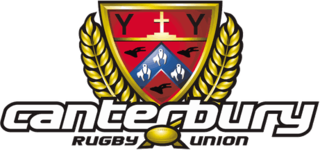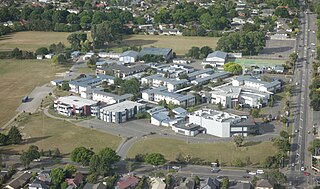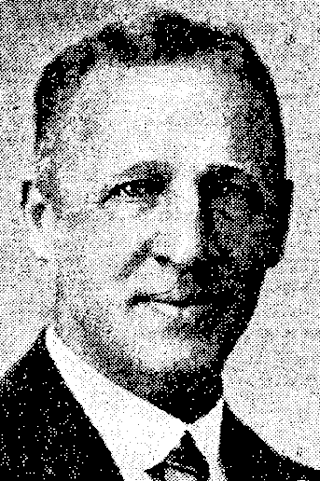Related Research Articles

Timaru is a port city in the southern Canterbury Region of New Zealand, located 157 km (98 mi) southwest of Christchurch and about 196 km (122 mi) northeast of Dunedin on the eastern Pacific coast of the South Island. The Timaru urban area is home to 28,600 people, and is the largest urban area in South Canterbury, and the second largest in the Canterbury Region overall, after Christchurch. The town is the seat of the Timaru District, which includes the surrounding rural area and the towns of Geraldine, Pleasant Point and Temuka, which combined have a total population of 48,500.

The Canterbury Rugby Football Union is the governing body for rugby union in a portion of the Canterbury region of New Zealand. Its colours are red and black in a hooped design. The CRFU govern the running of the Canterbury representative team which have won New Zealand's first-tier domestic competition National Provincial Championship 14 times including a "six-peat" from 2008 to 2013 – with five in the National Provincial Championship, two in the Air New Zealand Cup, five in the ITM Cup and one in the Mitre 10 Cup. Their most recent victory was the 2017 Mitre 10 Cup. Canterbury also acts as a primary feeder to the Crusaders, who play in the Super Rugby competition.

Burnside High School is a state co-educational secondary school located in the suburb of Burnside in Christchurch, New Zealand. With a roll of 2419 students, it is the largest school in New Zealand outside Auckland, and is among the country's four largest schools.

The Wellington Rugby Football Union are a New Zealand governing body of rugby union in the New Zealand province of Wellington Region. The main stadium is Sky Stadium which is located in Wellington. The union also represents the Wellington Lions, which is professional rugby union team who compete in the Mitre 10 Cup competition and contest for the Ranfurly Shield. Before 2006 the Lions competed in the National Provincial Championship.
The South Canterbury Rugby Football Union (SCRFU) is a rugby province based in the central South Island city of Timaru, New Zealand. The South Canterbury team play at Fraser Park located in Timaru.
Lyall Scott Barry was a school teacher and inspector, and wrote a history of the Waimumu area in Southland. As a swimmer he won two medals at the 1950 British Empire Games.
The 1928 New Zealand rugby league season was the 21st season of rugby league that had been played in New Zealand.
Daniel Henry Verner Du Vall was a New Zealand professional rugby league footballer who played in the 1910s. He played at representative level for New Zealand, and Hawke's Bay, as a Centre, i.e. number 3 or 4.
Sir Ronald Stewart Scott was a New Zealand sports administrator. He was the chairman of the organising committee for the 1974 Christchurch Commonwealth Games, and was Chef de Mission at the 1984 Olympic Games. In Wellington he helped establish the Westpac Stadium.
The 2014 New Year Honours in New Zealand were appointments by Elizabeth II in her right as Queen of New Zealand, on the advice of the New Zealand government, to various orders and honours to reward and highlight good works by New Zealanders, and to celebrate the passing of 2013 and the beginning of 2014. They were announced on 31 December 2013. In March 2023, the appointment of Lieutenant Colonel Duncan Roy as a Member of the New Zealand Order of Merit, not previously made public for security reasons, was published.
The 2005 New Year Honours in New Zealand were appointments by Elizabeth II in her right as Queen of New Zealand, on the advice of the New Zealand government, to various orders and honours to reward and highlight good works by New Zealanders, and to celebrate the passing of 2004 and the beginning of 2005. They were announced on 31 December 2004, and included gallantry awards for actions in East Timor.

Philip Stanley Foster was a New Zealand surgeon and cricketer.
New Zealand standard school buildings were largely developed and built in the 1950s, 1960s and 1970s. Following the Second World War, more schools and classrooms were needed to address the pre-existing shortage and to handle the increasing school population with the subsequent baby boom. Using standard designs allowed the demand to be met while reducing construction time and costs.
The 1978 New Year Honours in New Zealand were appointments by Elizabeth II on the advice of the New Zealand government to various orders and honours to reward and highlight good works by New Zealanders. The awards celebrated the passing of 1977 and the beginning of 1978, and were announced on 31 December 1977.
The 1995 New Year Honours in New Zealand were appointments by Elizabeth II in her right as Queen of New Zealand, on the advice of the New Zealand government, to various orders and honours to reward and highlight good works by New Zealanders, and to celebrate the passing of 1994 and the beginning of 1995. They were announced on 31 December 1994.
The 1982 New Year Honours in New Zealand were appointments by Elizabeth II on the advice of the New Zealand government to various orders and honours to reward and highlight good works by New Zealanders. The awards celebrated the passing of 1981 and the beginning of 1982, and were announced on 31 December 1981.
The 1985 New Year Honours in New Zealand were appointments by Elizabeth II on the advice of the New Zealand government to various orders and honours to reward and highlight good works by New Zealanders. The awards celebrated the passing of 1984 and the beginning of 1985, and were announced on 31 December 1984.
Maurice Rhodes Carter was a New Zealand property developer, philanthropist and local politician.
Clifford Samuel Gibbs was a New Zealand cricketer. He played in one first-class match in the Plunket Shield for Canterbury in 1930 and played in the Hawke Cup for Marlborough.
References
- ↑ "Death search: registration number 2017/18931". Births, deaths & marriages online. Department of Internal Affairs. Retrieved 25 July 2017.
- 1 2 3 Hunter, Allan (2015). "70th anniversary of the Normandy landings". 21st Annual report season 2014/2015 (PDF). The Willows Cricket Club. p. 59. Retrieved 15 July 2017.
- ↑ "Timaru Boys' High School remembers its past with Anzac Day service". Timaru Herald. 24 April 2015. Retrieved 15 July 2017.
- ↑ "NZ university graduates 1870–1961: Hi–Hy". Shadows of Time. Retrieved 15 July 2017.
- 1 2 3 4 Crean, Mike (27 May 2000). "Forgotten battalion". The Press. p. 8.
- 1 2 3 "Allan Hunter death notice". The Press. 14 July 2017. Retrieved 15 July 2017.
- ↑ Crean, Mike (24 May 2014). "Kiwi recalls greatest seaborne invasion". The Press. p. 9.
- 1 2 "Joan Esme Hunter (Tyler)". BillionGraves. Retrieved 15 July 2017.
- ↑ "Inter-school match". The Press. 27 June 1939. p. 12. Retrieved 15 July 2017.
- 1 2 Davis, Hanne (12 September 2015). "Hunter's heart with Hawke's Bay 66 years after regional call up". Stuff.co.nz. Retrieved 15 July 2017.
- ↑ Clarkson, David (22 July 2002). "'Search and rescue' part of book sale". The Press. p. 4.
- 1 2 Hunter, Allan (1995). Rotary in Bishopdale–Burnside 1974–1995 (PDF). Christchurch: Rotary Club of Bishopdale–Burnside. Archived from the original (PDF) on 22 February 2017. Retrieved 15 July 2017.
- ↑ "Queen's Birthday honours list 2005". Department of the Prime Minister and Cabinet. 6 June 2005. Retrieved 15 July 2017.